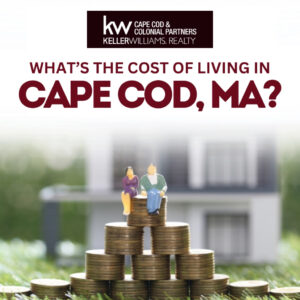Cape Cod is known for its charming coastal towns, stunning beaches, and laid-back lifestyle. It offers a unique quality of life with top-notch health care, education, and a strong business community. However, the area’s appeal as a desirable place to live comes with a high cost of living, which requires careful consideration when planning to move here.
Understanding Cape Cod’s cost of living is equally important when looking for a home in the area.
Overall Summary

Cape Cod’s location in Barnstable County has a cost of living index score of 131.5, compared to the state average of 127.5, which is notably higher.
One of the main reasons for this is the popularity of the neighborhoods in Cape Cod as vacation destinations and the limited land availability for development. This drives up the prices of essentials such as groceries, utilities, and healthcare compared to other areas in Massachusetts and the rest of the United States.
Housing Costs

Housing is often a significant contributor to a homeowner’s monthly expenses. The cost of housing in Cape Cod is 93% higher than the national average, reflecting the area’s desirability.
The average home value in Barnstable County, MA, is $731,433, showing a 5.7% increase over the past year. Homes for sale in Cape Cod often range from $4,000 to $15 million. The median sale price is $685,417, while the median list price is $848,767.
Homes are selling faster, with an average of 15 days on the market, indicating intense buyer competition. Cape Cod’s appeal as both a residential and vacation destination will likely sustain high demand, so it’s essential to plan your finances to move to this region.
Renting vs. Buying

Buying a house in Cape Cod can be a wise choice for several reasons, such as its inherent appeal as a popular location for both residents and vacationers. With limited land availability and high demand, property values in Cape Cod are likely to appreciate over time, offering the potential for significant ROI.
On the other hand, renting may be a better fit if you value flexibility, are looking for a more affordable option, or are still determining your long-term plans. Cape Cod offers many rental properties, from convenient units to cozy cottages and spacious beach houses!
The average rent price in Cape Cod is $2,082, though costs vary based on the location and features, such as water-front properties. The rental rates in Cape Cod also depend on the number of bedrooms and other property features.
| Bedroom Counts | Average Rate |
|---|---|
| Studio | $1,486 |
| 1 Bedroom | $1,585 |
| 2 Bedroom | $2,082 |
| 3 Bedroom | $2,541 |
| 4 Bedroom | $2,897 |
Utility Expenses in Cape Cod

Utility cost index score of 115.9 in Barnstable County is 16% higher than the national average. Cape Cod’s cost of living includes higher-than-average utility expenses, with monthly fees for a 915 sq ft apartment reaching $171.66—about 11% above the national average.
Below is the breakdown of the average bill for utilities in Cape Cod.
| Utility | Average Bill |
|---|---|
| Electricity | $355 |
| Gas | $3 |
| Cable and Internet | $100 |
| Phone Bill | $184.49 |
| Water | $34 |
Food and Groceries

Food expenses are another significant factor in the cost of living in Cape Cod that you must consider. Cape Cod has a wide array of dining choices, and grocery stores offer various items, allowing you to dine outside or cook at home.
Here’s an overview of the average costs for dining and grocery items in Cape Cod, Massachusetts.
| Grocery Products / Type of Dining | Average Cost |
|---|---|
| Dinner in a Mid-Range Restaurant | $75 |
| Fast food Restaurants | $10 |
| Rice | $3.08 |
| Bakery Products | $3 |
| Dairy Products | $7 |
| A dozen of eggs | $4.25 |
| Fruits and Vegetables | $4 |
| Meat and Seafood | $9 |
| 1.5L Water | $2.49 |
| Beverages | $7 |

Getting around the area requires a car or through public transportation.
Transportation costs in Cape Cod are slightly below the national average, with a score of 97.0. With an average commute time of 26.7 minutes, Cape Cod transportation is affordable and relatively convenient for residents.
| Type | Cost |
|---|---|
| One Way Ticket | $2 |
| Taxi Ride | $4 |
| Gasoline (1 Gallon) | $2.89 |
Healthcare Expenses

Another significant factor to consider when planning to move to another place is healthcare, a substantial part of Cape Cod’s cost of living.
Healthcare costs in Cape Cod are relatively affordable, scoring 93.3, which is 6.7% lower than the national average. Here’s the breakdown of the average price of healthcare for typical Cape Cod residents.
| Health Care | Average Cost |
|---|---|
| Doctor’s Visit | $120 |
| Dental Cleaning | $100 |
| Fitness Club Membership | $45 |
To learn more about Cape Cod’s healthcare sector and other services, you can visit this list of local services you may want to know before moving to the area.
Cost of Living Comparison

1. Cape Cod vs Martha's Vineyard
Martha’s Vineyard, MA, is more expensive than Cape Cod, although both are more expensive than the national average.
Cape Cod’s median home price is $685,417, whereas Martha’s Vineyard’s median sale price is significantly higher at $1.5 million. Rental prices on Cape Cod average $2,082 per month, while vacation rentals on Martha’s Vineyard can cost around $4,500.
Food costs are generally the same, depending on the product. For instance, eating outside can be more expensive in Martha’s Vineyard, but groceries can be more affordable. Transportation and utility costs are both costly, but when it comes to getting around Martha’s Vineyard, biking is another cost-effective option for a cheaper price.
2. Cape Cod vs Nantucket
The cost of living in Cape Cod, MA, and Nantucket, MA, both reflect their popularity as vacation destinations, but Nantucket is significantly more expensive.
Overall, the cost of living in Nantucket is 58% above the national average, compared to Cape Cod’s cost of living, which is 31.5% higher than the national average.
Cape Cod’s average home value is $731,433, and monthly rent is averaging around $2,082. In contrast, in Nantucket, home prices average $2,812,412, and rent is around $4,150.
Utility costs are also higher in Nantucket, with monthly bills reaching $196.76 compared to $171.66 in Cape Cod. Groceries in Nantucket are also more costly, with higher prices for bread and milk.
Conclusion
Cape Cod offers a quality life with charming coastal towns, stunning beaches, and quality amenities. However, this appeal comes with a high cost of living, driven mainly by limited land availability and popularity as a vacation destination.
Want to learn more about Cape Cod, Massachusetts? Do not hesitate to book an appointment with our team! You may reach us by calling 508-846-2243. We will gladly assist you with your inquiries and needs as you journey to coastal living!
Frequently Asked Questions
1. Is Cape Cod an expensive place to live year-round?
Yes, Cape Cod is an expensive place to live year-round. The cost of living is notably higher than the state and national averages, mainly due to the area’s desirability as a vacation destination and limited land for development. Housing, utilities, groceries, and transportation are more costly than neighboring cities.
2. How do housing costs in Cape Cod compare to nearby areas like Boston?
Housing costs in Cape Cod are generally lower than in Boston, though they remain higher than the national average.
The average home value in Cape Cod is approximately $731,433, while in Boston, the average home value is $750,816 due to urban demand and limited housing availability. However, Cape Cod still presents challenges with housing affordability, mainly because it is both a residential and a vacation hotspot.
3. What are the best ways to save money while living in Cape Cod?
If you’re uncertain about your long-term plans and want to save money while living on Cape Cod, consider renting instead of buying a home.
Shopping at local farmers’ markets can reduce grocery expenses, and public transportation can help minimize commuting costs.
4. Are utilities more expensive in Cape Cod than in other regions?
Yes, utilities in Cape Cod are more expensive than in many other regions. The utility cost index in Barnstable County is 16% higher than the national average.
Monthly costs for a typical apartment are around $171.66, and utility bills, including electricity, cable, and water, are higher due to the area’s infrastructure and energy needs.
5. Is healthcare in Cape Cod easily accessible, and how much does it cost?
Healthcare in Cape Cod is generally accessible, with quality facilities available throughout the region. Costs are relatively affordable compared to the national average, and the healthcare index is lower than the national average.





